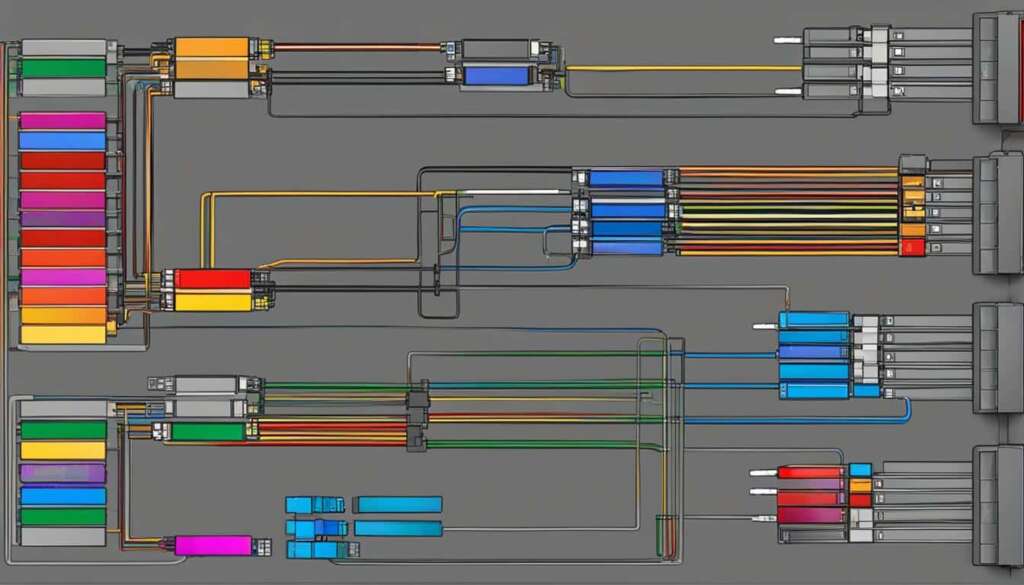Table of Contents
In today’s digital age, computer networking has become an integral part of our lives. From browsing the internet to transferring files, we rely on computer networks for almost everything. However, behind this seemingly simple process lies a complex system of protocols and mechanisms that make it all work. One such mechanism is the use of port numbers, which play a crucial role in establishing connections between devices and facilitating online communications and data transfer.
Key Takeaways
- Port numbers are numerical identifiers used to identify specific processes or services on a device.
- Port numbers facilitate online communications by allowing devices to identify the intended recipient of a message or data packet.
- Port forwarding enables devices behind a firewall to receive incoming communications.
- Port numbers are essential in establishing both TCP and UDP connections.
- Understanding port numbers is crucial for anyone working with computer networks.
What is a Port Number?
Port numbers are essential components of modern computer networks. A port number is a numerical identifier assigned to specific processes or services on a device. Each process or service, whether it is a web browser, email client, or file-sharing application, is assigned a unique port number to ensure that it can receive incoming data packets.
Port numbers are 16-bit unsigned integers, which means there are 65,536 possible port numbers available for use. Port numbers are divided into three ranges: well-known ports, registered ports, and dynamic or private ports.
The well-known ports, ranging from 0 to 1023, are reserved for specific services, such as HTTP (port 80), FTP (port 21), and SSH (port 22). The registered ports, ranging from 1024 to 49151, are used by applications and services registered with the Internet Assigned Numbers Authority (IANA). The dynamic or private ports, ranging from 49152 to 65535, can be used freely and are not registered with IANA.
| Port Number Type | Port Number Range | Description |
|---|---|---|
| Well-Known Ports | 0-1023 | Reserved for specific services |
| Registered Ports | 1024-49151 | Used by registered applications and services |
| Dynamic or Private Ports | 49152-65535 | Free to use and not registered with IANA |
Different types of port numbers are used depending on the specific needs of the application or service. For example, well-known ports are typically used for established services, while dynamic or private ports are more commonly used for temporary or ad hoc connections.
How Port Numbers Facilitate Online Communications
In the world of computer networking, port numbers play a critical role in facilitating online communications. Every device on a network has a unique IP (Internet Protocol) address assigned to it, which enables it to send and receive data over the network. However, in order for the data to reach the intended recipient, the destination device needs to know which application or service on that device should receive the data.
This is where port numbers come in. A port number is a 16-bit unsigned integer that identifies a specific process or service running on a device. When a device receives a message or data packet, it examines the destination IP address and port number to determine which application or service the data should be directed to. By using this information, the device can ensure that the data is delivered to the correct application or service.
For example, when you open a web browser and enter a URL (Uniform Resource Locator) such as www.example.com, the browser sends a request to the server at that URL. The request includes the destination IP address and port number, which enables the server to identify which application or service should process the request.
| Common Port Numbers for Online Communications | Protocol Type |
|---|---|
| 80 | HTTP (Hypertext Transfer Protocol) |
| 443 | HTTPS (HTTP Secure) |
| 25 | SMTP (Simple Mail Transfer Protocol) |
| 110 | POP3 (Post Office Protocol version 3) |
| 143 | IMAP4 (Internet Message Access Protocol version 4) |
Many common online services rely on specific port numbers to function properly. For instance, HTTP (used for web browsing) typically uses port number 80, while HTTPS (for secure browsing) uses port number 443. Similarly, email services such as SMTP, POP3, and IMAP4 use specific port numbers to enable the transfer of email messages over the internet.
However, when devices are located behind a firewall, it can be challenging for incoming communications to reach them. This is where port forwarding comes in. Port forwarding is a process that enables devices behind a firewall to receive incoming communications by redirecting those communications to a specific port number on the device. This allows devices to receive incoming communications even though they are not directly visible or accessible on the internet.
The Bottom Line
Port numbers are essential components of online communications, enabling devices to identify the intended recipient of a message or data packet. By using port numbers, devices can ensure that communications are delivered to the correct application or service, facilitating effective and efficient online interactions.
The Significance of Port Numbers in Data Transfer
In computer networking, port numbers play a vital role in facilitating data transfer. Port numbers help identify the intended recipient of data packets and ensure that the communication reaches the correct application or service. Furthermore, port numbers are essential in establishing both TCP (Transmission Control Protocol) and UDP (User Datagram Protocol) connections.
Transmission Control Protocol (TCP) is a reliable, connection-oriented protocol that guarantees all data packets are delivered error-free. TCP connections require a three-step handshake process to establish a connection between devices. During this process, the devices exchange information regarding the port numbers they will use for data transfer.
User Datagram Protocol (UDP), on the other hand, is a connectionless protocol that does not guarantee reliable data transfer. Unlike TCP, UDP does not require a three-step handshake or establish a connection before data transfer.
As a result, the choice between TCP and UDP connections depends on the specific requirements of the application. Some applications, such as email servers and file transfer services, require reliable data transfer and, therefore, use TCP connections. Meanwhile, applications that prioritize speed and efficiency, such as online gaming and video streaming, rely on UDP connections.
The Role of Port Numbers in Reliable Data Transfer
“Port numbers help ensure that packets are delivered to the right application on the receiving device, which is crucial for reliable data transfer.”
Source: Joe Lynch, Network Computing
Port numbers are essential in ensuring reliable data transfer, as they help establish connections between devices and route data packets to the intended recipient. In TCP connections, each data packet contains source and destination port numbers, enabling devices to establish a reliable, error-free connection. Meanwhile, in UDP connections, the device uses source and destination port numbers to route data packets efficiently, without establishing a connection beforehand.
The Different Types of Port Numbers
Port numbers are divided into three ranges: well-known ports (0-1023), registered ports (1024-49151), and dynamic or private ports (49152-65535). Well-known ports are reserved for specific services, such as HTTP (port 80) and FTP (port21), while registered ports are assigned to software applications by the Internet Assigned Numbers Authority (IANA). Dynamic or private ports are used for short-term communication and are assigned dynamically by the operating system.
| Port Number Range | Description | Examples |
|---|---|---|
| 0-1023 | Well-known ports reserved for system processes and services | HTTP (80), FTP (21), SSH (22), Telnet (23) |
| 1024-49151 | Registered ports assigned by IANA to software applications | MySQL (3306), Oracle (1521), BitTorrent (6881) |
| 49152-65535 | Dynamic or private ports assigned dynamically by the operating system |
Understanding the range and types of port numbers is crucial for network administrators and IT professionals, as it helps them manage network traffic and monitor for potential security risks.
Conclusion
Port numbers are fundamental to the world of computer networking, serving as crucial identifiers for processes and services. As we have seen, understanding port numbers is essential for anyone working with computer networks, as they enable devices to establish connections, facilitate online communications, and transfer data efficiently and securely.
Whether you are a network administrator, a software developer, or simply someone interested in how the internet works, knowing about port numbers is crucial. With the knowledge and understanding of port numbers, you can ensure that your devices remain secure and that your online interactions are reliable and efficient.
So, take the time to learn more about port numbers and how they function in computer networking. With this knowledge, you can take your skills and expertise to the next level and contribute to the development of more secure, efficient, and reliable networks in the future.
FAQ
What are port numbers in computer networking?
Port numbers in computer networking are numerical identifiers assigned to specific processes or services on a device. They play a crucial role in establishing connections between devices and facilitating online communications and data transfer.
How do port numbers facilitate online communications?
Port numbers enable devices to identify the intended recipient of a message or data packet, ensuring that the communication reaches the correct application or service. Port numbers also allow for port forwarding, which helps devices behind a firewall receive incoming communications.
What is the significance of port numbers in data transfer?
Port numbers are essential in establishing TCP (Transmission Control Protocol) and UDP (User Datagram Protocol) connections. They help ensure reliable and efficient data transfer by identifying the processes or services involved in the communication.
What is the range of port numbers?
Port numbers range from 0 to 65535. Certain port numbers are reserved for specific purposes, such as well-known ports (0-1023) for commonly used services like HTTP (port 80) and FTP (port 21).
How can I find information about specific port numbers?
You can refer to the Internet Assigned Numbers Authority (IANA) service names and port numbers registry to find information about specific port numbers. This registry provides details on the protocols, services, and applications associated with each port number.













